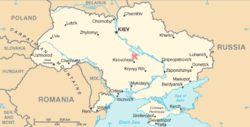
Boltysh crater
Did you know...
SOS Children, an education charity, organised this selection. SOS mothers each look after a a family of sponsored children.
The Boltysh Crater is an impact crater in the Kirovohrad Oblast province of Ukraine. The crater is 24 km in diameter and its age of 65.17 ± 0.64 million years, based on argon dating techniques, is within error of that of Chicxulub Crater in Mexico, and the KT boundary. The Chicxulub impact is believed to have caused the mass extinction at the end of the Cretaceous era, which included the extinction of the dinosaurs.
As well as Boltysh, several other impact craters around the world have estimated ages of about 65 million years, leading to the suggestion that the Earth was struck by multiple impactors at that time. The collision of Comet Shoemaker-Levy 9 with Jupiter in 1994 showed that such multiple impacts over a few days are possible.
Overview
Boltysh Crater is located in central Ukraine, in the basin of the Tiasmyn River, a tributary of the Dnieper River. It is 24 km in diameter, and is surrounded by an ejecta blanket of breccia preserved over an area of 6500 km². It is estimated that immediately after the impact, ejecta covered an area of 25,000 km² to a depth of 1 m or greater, and was some 600 m deep at the crater rim.
The crater contains a central uplift about 6 km in diameter, rising about 550 m above the base level of the crater. This uplift currently lies beneath about 500 m of sediment deposited since the impact, and was discovered in the 1960s during oil exploration.
Age
When first identified, the age of the crater could only be roughly constrained between the age of the impacted rocks (the target) and the age of overlying sediments. The target rocks date from the Cenomanian (98.9 to 93.5 million years ago) and Turonian (93.5 to 89 million years ago) epochs. Bore samples of sediments overlying the crater contain fossils dating from the Paleocene epoch, 65 to 54.8 million years ago. The age of the crater was thus constrained to between 54.8 and 98.9 million years.
Subsequent radiometric dating reduced the uncertainty. The concentration of uranium-238 decay products in impact glasses from the crater were used to derive an age of 65.04 ± 1.10 million years. Analysis of argon radioactive decay products yielded an age of 65.17 ± 0.64 million years. These ages are similar to that of Chicxulub Crater.
Likelihood of multiple impact
Although the ages derived for Chicxulub and Boltysh are the same to within their statistical errors, it does not necessarily follow that they formed at exactly the same time. At the estimated rate of impacts on the Earth, it would not be extremely unusual for a Boltysh-sized crater to be formed within half a million years of Chicxulub. The dating of these impact craters is not yet accurate enough to establish whether the impactors arrived thousands of years apart, perhaps as part of a generally elevated rate of impacts at that time, or were almost simultaneous, like the impacts of the fragments of Comet Shoemaker-Levy 9 on Jupiter in 1994.
The discovery of the unconfirmed Silverpit crater and the early report of its age as 65 – 60 million years initially gave greater weight to the hypothesis that the Earth was struck by multiple impactors at this time, however, the age estimate has now been broadened to 74 – 45 million years.
The controversial Shiva crater is claimed to have formed around the same time, but its status as an impact crater is disputed.

